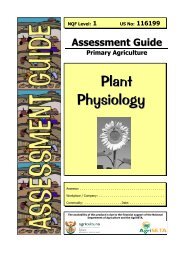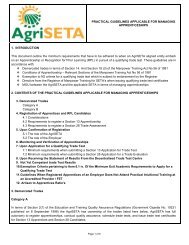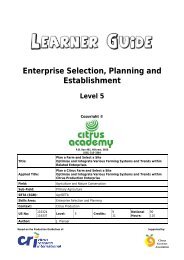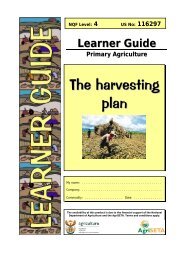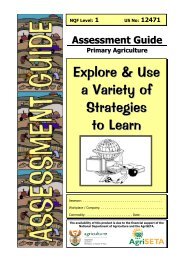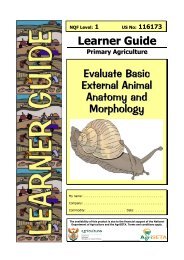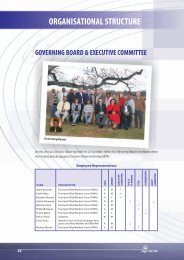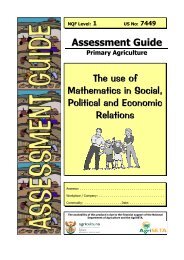Harvest Animal Products - AgriSETA
Harvest Animal Products - AgriSETA
Harvest Animal Products - AgriSETA
Create successful ePaper yourself
Turn your PDF publications into a flip-book with our unique Google optimized e-Paper software.
NQF Level: 1 US No: 116198Assessment GuidePrimary Agriculture<strong>Harvest</strong><strong>Animal</strong> <strong>Products</strong>Assessor: . . . . . . . . . . . . . . . . . . . . . . . . . . . . . . . . . . . . . . . . . .Workplace / Company: . . . . . . . . . . . . . . . . . . . . . . . . . . . . . . . . .Commodity: . . . . . . . . . . . . . . . . . . . Date: . . . . . . . . . . . . . . . . .The availability of this product is due to the financial support of the NationalDepartment of Agriculture and the <strong>AgriSETA</strong>. Terms and conditions apply.
<strong>Harvest</strong> <strong>Animal</strong> <strong>Products</strong>Primary Agriculture NQF Level 1 Unit Standard No: 1161982Before we start…This assessment guide contains all necessary activitiesand instructions that will enable the assessor andlearner to gather evidence of the learner’s competenceas required by the unit standard. This guide wasdesigned to be used by a trained and accredited assessorwhom is registered to assess this specific unit standardas per the requirements of the <strong>AgriSETA</strong> ETQA.Prior to the delivery of the program the facilitator andassessor must familiarise themselves with content of thisguide, as well as the content of the relevant LearnerWorkbook.The assessor, facilitator and learner must plan the assessment process together, inorder to offer the learner the maximum support, and the opportunity to reflectcompetence.The policies and procedures that are required during the application of thisassessment are available on the website of the <strong>AgriSETA</strong>. The assessor mustfamiliarise him/herself with this document before proceeding.This guide provides step-by-step instructions for the assessment process of:Title:<strong>Harvest</strong> <strong>Animal</strong> <strong>Products</strong>Please Note:This Unit Standard116198 AssessmentGuide must be read inconjunction with thegeneric AssessorGuide as prescribedand published by the<strong>AgriSETA</strong>.US No: 116198 NQF Level: 1 Credits: 5This unit standard is one of the building blocks in the qualification listed below.Please mark the qualification you are currently assessing, because that will bedetermined by the context of application:Title ID Number NQF Level Credits MarkNational Certificate in <strong>Animal</strong> Production 48970 1 120 Please mark the learning program you areenrolled in:Are you enrolled in a: Y NLearnership? Skills Program? Short Course? Note to Assessor:If you are assessing thismodule as part of a fullqualification or learnership,please ensure that you havefamiliarized yourself with thecontent of the qualification.Version: 01 Version Date: July 2006
<strong>Harvest</strong> <strong>Animal</strong> <strong>Products</strong>Primary Agriculture NQF Level 1 Unit Standard No: 11619831SO 1Instructions to learner:Group discussion and self test.Learner Workbook: Page 3 Facilitator Guide: Page 111 (a) Name at least 5 products of animal origin.Model Answer(s):The learner may capture answers such as: MeatWoolMohairEggsFeathersEtc.1 (b) List the different ways that animal products can be harvested.Model Answer(s):The learner may capture answers such as: MilkingShearingPluckingSlaughter.1 (c) Describe how the harvested products are stored.Model Answer(s):The learner may capture answers such as: Wool and Mohair are stored in bales.Meat and milk must be refrigerated.Version: 01 Version Date: July 2006
<strong>Harvest</strong> <strong>Animal</strong> <strong>Products</strong>Primary Agriculture NQF Level 1 Unit Standard No: 11619841 (c) Self testCan the learner complete the self test correctly?Model answer(s):1 Cows produce milk after C2 The length of the wool fibre is important for A3 The diameter of a wool fibre is important for F4 Daylight length plays a important role in B5 <strong>Animal</strong> horns and hooves are used to manufacture G6 <strong>Animal</strong> skins are used to manufacture D7 <strong>Animal</strong> bones can be ground and used as E8 Ostriches produce I9 Most meat are classified to inform the customer of its J10 Byproducts of milk HMy Notes …. . . . . . . . . . . . . . . . . . . . . . . . . . . . . . . . . . . . . . . . . . . . . . . . . . . . . . . . . . . . . . . . . . . . . . . . . . . . . . . . . . .. . . . . . . . . . . . . . . . . . . . . . . . . . . . . . . . . . . . . . . . . . . . . . . . . . . . . . . . . . . . . . . . . . . . . .. . . . . . . . . . . . . .. . . . . . . . . . . . . . . . . . . . . . . . . . . . . . . . . . . . . . . . . . . . . . . . . . . . . . . . . . . . . . . . . . . . . . . . . . . . . . . . . . .. . . . . . . . . . . . . . . . . . . . . . . . . . . . . . . . . . . . . . . . . . . . . . . . . . . . . . . . . . . . . . . . . . . . . . . . . . . . . . . . . . .. . . . . . . . . . . . . . . . . . . . . . . . . . . . . . . . . . . . . . . . . . . . . . . . . . . . . . . . . . . . . . . . . . . . . . . . . . . . . . . . . . .. . . . . . . . . . . . . . . . . . . . . . . . . . . . . . . . . . . . . . . . . . . . . . . . . . . . . . . . . . . . . . . . . . . . . . . . . . . . . . . . . . .. . . . . . . . . . . . . . . . . . . . . . . . . . . . . . . . . . . . . . .. . . . . . . . . . . . . . . . . . . . . . . . . . . . . . . . . . . . . . . . . . . . .. . . . . . . . . . . . . . . . . . . . . . . . . . . .. . . . . . . . . . . . . . . . . . . . . . . . . . . . . . . . . . . . . . . . . . . . . . . . . . . . . . . .. . . . . . . . . . . . . . . . . . . . . . . . . . . . . .. . . . . . . . . . . . . . . . . . . . . . . . . . . . . . . . . . . . . . . . . . . . . . . . . . . . . .. . . . . . . . . . . . . . . . . . . . . . . . . . . . . . . . . . . . . . . . . . . . . . . . . . . . . . . . . . . . . . . . . . . . . . . . . . . . . . . . . . .. . . . . . . . . . . . . . . . . . . . . . . . . . . . . . . . . . . . . . . . . . . . . . . . . . . . . . . . . . . . . . . . . . . . . . . . . . . . . . . . . . .. . . . . . . . . . . . . . . . . . . . . . . . . . . . . . . . . . . . . . . . . . . . . . . . . . . . . . . . . . . . . . . . . . . . . . . . . . . . . . . . . . .. . . . . . . . . . . . . . . . . . . . . . . . . . . . . . . . . . . . . . . . . . . . . . . . . . . . . . . . . . . . . . . . . . . . . . . . . . . . . . . . . . .. . . . . . . . . . . . . . . . . . . . . . . . . . . . . . . . . . . . . . . . . . . . . . . . . . . . . . . . . . . . . . . . . . . . . . . . . . . . . . . . . . .Version: 01 Version Date: July 2006
<strong>Harvest</strong> <strong>Animal</strong> <strong>Products</strong>Primary Agriculture NQF Level 1 Unit Standard No: 11619852SO 2Instructions to learner:Group homework, written report and self test.Learner Workbook: Page 5 Facilitator Guide: Page 122 (a) Describe the quality characteristics and classification systems used forproducts at harvestingModel Answer(s):The learner may capture answers such as:The quality characteristics and classification system used for wool or mohair atharvesting: Diameter of fibres Lengths of fibres Freedom from foreign materials such as burrs or seedsThe quality characteristics and classification system used for meat at harvesting: Fat content of the meat Tenderness of the meat Age of the animal Body conformation or conditions score of the animal.The quality characteristics and classification system used for feathers atharvesting: Colour of feathers Size of feathers Freedom from foreign materials.2 (b) Self testCan the learner complete the self test correctly?Model answer(s):1 Fine, long mohair is C2 Ostrich feathers from the wings are A3 Young, well-fed calves will have less B4 Hair produced by young angora goats will have a E5 The very light fine feathers produced by geese and ducks, betweentheir feathers are called6 Wool is shorn most of the time between J7 Mohair is shorn most of the time at intervals of F8 Young calves are slaughtered depending on their I9 The mass of a lambs carcass will be approximately G10 Mohair grows approximately at HDVersion: 01 Version Date: July 2006
<strong>Harvest</strong> <strong>Animal</strong> <strong>Products</strong>Primary Agriculture NQF Level 1 Unit Standard No: 11619863SO 3 & 4Instructions to learner:Individual homework assignments and written reports (3a and3b)Learner Workbook: Page 7 Facilitator Guide: Page 133 (a) Demonstrate knowledge of scarce animal products.Model Answer(s):The learner may capture answers such as:The use of horns and hooves to manufacture products such as: Glue Glutton Dog chew-toys.The use of bees to produce products such as: Royal jelly Propolis.The use of animals to produce products from their manure such as: Guano Fertilizer <strong>Animal</strong> feed.3 (b) Demonstrate knowledge of milking equipment used in modern dairies.Model answer(s):The learner may capture answers such as:Milking machines:The milking machine extracts milk from allteats simultaneouslyMilking machines are used to extract milkfrom cows or goats when the herd is largerthan about 4 milking animals. Milkingmachines work by using a pulsating vacuumto cause a rubber sleeve round each teat tosimulate the effect ofVersion: 01 Version Date: July 2006
<strong>Harvest</strong> <strong>Animal</strong> <strong>Products</strong>Primary Agriculture NQF Level 1 Unit Standard No: 1161987hand-milking or of a suckling calf. Vacuum in another pipe transports the flowingmilk either to a local container (usually sized to the output of one cow) or, inseries with a mechanical pump and heat-exchanger, to a central storage vat,usually refrigerated in most countries.The pulsations of the teat sleeve arecontrolled by mechanical devices in older machines but modern ones haveelectronic controls to enhance the milking action.Milking machines keep the milk enclosed and safe from external contamination.However keeping the milk-transport pipes clean internally is a problem that ismore or less solved by adequate washing with chemical solvents and waterrinses. Most metalwork in contact with milk should be stainless steel (corrosionresistantsteel) and synthetic rubber is specially designed for milking and milkcontact.Most milking machines are powered by electricity but, in case of electrical failure,there can be an alternative means of motive power, often an internal combustionengine, for the vacuum and milk pumps because milking cows cannot toleratedelays in their scheduled milking without suffering serious milk productionreductionsHow Hand Milking Extracts MilkDuring hand milking of a cow, manual cleaning &massage of the udder stimulates milk let-down. Theteat is closed at the base of the udder and thenmanual pressure is applied to the teat to force thetrapped milk out of the teat opening. Hand milkingis dependant on increased pressure within the teatto overcome the resistance of the teat sphincter. This is NOT the way milk isremoved by nursing calves or milking machines.How Calf-suckling Extracts MilkThe presence of the calf and its "bunting" of the udder stimulates milk let-down.As a calf nurses a cow, it does not clamp off the base of the teat nor put muchpressure on the walls of the teat. But as the calf sucks, a negative pressure isproduced in the mouth. Thepressure within the udder, createdby atmospheric pressure and bymilk letdown is greater than thearea of negative pressure withinthe calf's mouth. The resistance ofthe teat sphincter is overcome andthe milk flows rapidly into thecalf's mouth (the area of reducedpressure).Version: 01 Version Date: July 2006
<strong>Harvest</strong> <strong>Animal</strong> <strong>Products</strong>Primary Agriculture NQF Level 1 Unit Standard No: 1161988How the milking machine works... A milking machine functions the same as a nursingcalf. The reduced pressure within the shell- inflation causes the milk to flow out from the teatand udder and into the milking system.Pulsation System The pulsation system allows the inflation (shell liner) to close and applypressure to the teat end. It does this by allowing atmospheric air to enter between the shelland the inflation. The purpose is to massage the teat end and force tissue fluids back out ofthe teat end. This is a diagram of a very simple, older milking machine system. Yet itcontains most of the components of the more modern and more complicated system.Version: 01 Version Date: July 2006
<strong>Harvest</strong> <strong>Animal</strong> <strong>Products</strong>Primary Agriculture NQF Level 1 Unit Standard No: 11619894SO 4Instructions to learner:Group Field Trip, discussion and individual written reportLearner Workbook: Page 10 Facilitator Guide: Page 141. Describe the process of the harvesting of animal products?Model answer(s):The learner may capture answers such as:MOHAIR: SHEARINGTo simplify classing it is important that the following steps be followed:-1. CrutchingsIt is good policy to crutch Angora goats at 3 months (3 months growth of hair) to preventunnecessary stained hair. At the same time the fringe (kuif) can also be shorn to ensure bettervision for the goat.2. Number of shearersDo not use too many shearers - four to one classer is sufficient. In the case of two classers -six shearers may be used. Mohair is a fibre that takes time to class correctly and by rushingyour shearing, you will not be able to class to your advantage. Do not urge your shearers toshear faster - rather make sure that they do a neat job.3. Age groupsA good method to follow is to divide the Angora goats prior to shearing strictly according toage groups, e.g. mature goats, full-mouth goats, four to six tooth goats, two/tooth goats andkids. Start by shearing the mature goats first, followed by the full-mouth goats, etc. Also shearthe wethers (kapaters) separately. Should their hair have the same fineness as that of theewes, it can be grouped together - if different, keep separate.4 Method of shearingHair from the heads (kuif) often causes problems and the best way of keeping this hairseparate is to place a basket at the entrance of the catching pen and let each shearer shearoff the head fringe and place it in the basket before commencing shearing. As alreadymentioned the adults must be shorn first. The reason for this is that if you shear adults afterhaving shorn fine soft handling kids, the adult hair will appear to be rough and strong and youwill be inclined to class it down.Shear out the belly first and put it on the bellies table. The stain and Lox are then shorn andput on the stain and Lox table. By keeping the bellies apart, Lox and Stain cannot stain theclean bellies.Version: 01 Version Date: July 2006
<strong>Harvest</strong> <strong>Animal</strong> <strong>Products</strong>Primary Agriculture NQF Level 1 Unit Standard No: 11619810The short hair on the legs can thereafter be shorn separately. This will prevent any short hairbecoming mixed with the fleece.The fleece must now be shorn as evenly as possible and kept as intact as possible. The fleeceis picked up and thrown on the fleece table, with the shorn side underneath so that all theproperties can easily be seen.5. Dividing the fleeceAll stained, Lox and short pieces which may still appear in the fleece, are now removed. Theneck, which is usually stronger than the main fleece, is then removed, followed by the britchesand any seedy hair which may be present.Should the fleece be very even, it can be kept intact. Often however, the fleece has to bedivided into fine and strong parts, while some with good style-and-character should be keptseparately from the ones appearing less solid. Should the hair on the back appear to be veryweathered, it is also removed and added to the lines where it fits in.Model answer(s):The learner may capture answers such as:CORRECT FLAYING OF A SKIN1. IntroductionThe factors which determine the suitability of a tanned hide or skin donot start with the curing process, but with the removal of the hide orskin from the carcass. When once it has been removed from thecarcass, the handling it receives immediately thereafter is of vitalimportance for the retention of quality. The final shape of the hide orskin is more important than most people realise. The value of theprocessed hide or skin depends on the way in which the cutting lines aremade on the carcass.The preparation begins with flaying or the removal of the hide or skinfrom the animal after slaughtering, followed by curing of the hide or skinby the addition of salt to dry and preserve the material until it can beprocessed further into leather. By carefully following the variouspreparation steps the value of the leather can be conserved. The correctpreparation steps are discussed below.2. Slaughtering and flayingSlaughtering should be done early in the morning or late in the afternoon when thetemperature is low and the air is cool to prevent bacterial growth on the hide or skin. It is alsoimportant to bleed the animal well after slaughter, otherwise the blood stays behind in theskin and the blood veins will show in the grain surface of the leather. This can also happenwhen dead or very old animals are slaughtered. Poor handling of carcasses after slaughteringcan also damage the skin.Version: 01 Version Date: July 2006
<strong>Harvest</strong> <strong>Animal</strong> <strong>Products</strong>Primary Agriculture NQF Level 1 Unit Standard No: 116198112.1 Ripping linesThese are the cutting lines along which the skin is to be removed from the carcass. When thewrong lines are used, the value of the skin is reduced. The right ripping lines are shown in thefigure to the right.2.2 Hints on removing the skinBlood should be drained from the carcass taking care that the minimum amount of bloodcontaminates the skin or comes into contact with the hide or the skin. This will discouragebacterial spoilage.Use a sharp flaying knife with a rounded blade so as to avoid bad flays cuts on the hide orskin. Do not use the flaying knife where it is possible to simply pull the skin from the carcass.However, pulling too hard will result in “butchers strain” marks on the leather.Remove the hide or skin from the animal immediately after slaughter and allow the hide orskin to cool off in a clean place out of the sun and off the ground to prevent bacterialcontamination.Blood and dirt on hides and skins can be washed off with clean cold water.3. CuringThe aim of curing hides and skins is to make them resistant to bacterial attack, they can thenbe transported or stored until the tanner is able to process them. There are three methodscommonly used for salt curing hides or skins, which are as follows.3.1 Wet- saltingCover the flesh side of the hide or skin with salt and stack the skins in a pile. The salt takes upthe water inside the hide or skin and draws off a mixture of blood and water. Most bacteriawill not increase in numbers in very salty water.3.2 Dry saltingThe salting hide or skin is hung in the shade to dry or dried in hot air in tunnels where theclimate is wet. Dry salting is usually carried out in places where salt can be bought, butstorage and transporting of wet salted hides is difficult. The method of application is the sameas for wet salting. After the minimum treatment period of 48 hrs where the hides or skin havebeen in contact with the salt, the loose salt is shaken off and the hides or skins are then driedby hanging symmetrically along the line of the backbone over horizontal poles with diametersnot less than 7 centimeters. The hides or skins are placed initially with the flesh sideuppermost on the poles for drying and then turned over with the hair side uppermost tocomplete the drying on the wool side.3.3 Air-dryingIf it is difficult to get salt for curing, the skins can be dried by air, but only in dry climates. Theskins should be dried in the shade, with sufficient air movement otherwise the outside of theskin will dry too fast, leaving the inside wet and the skin will rot on the inside. They can behung over poles as described for dry salting or the skins can be stretched with strings from allsides in the frame to let the skin dry uniformly.Version: 01 Version Date: July 2006
<strong>Harvest</strong> <strong>Animal</strong> <strong>Products</strong>Primary Agriculture NQF Level 1 Unit Standard No: 11619812Summative Test and Attitude &Attribute EvaluationBefore the knowledge test is undertaken, the learner must be reminded of what isexpected from him / her in terms of summative and reflexive competence. Readand explain to the learner, the Preparation for Your Final Assessment section inthe learner workbook. Learners and assessor should sign off this section toacknowledge that this step was completed.Please set up a knowledge test from the questions given as a guideline to learnersand supply each learner with a test sheet.Supply each report with the following heading:Unit Standard: 116198 NQF Level: 1Learner Name:QuestionsModel Answers1. Name 5 products of animal origin. Feathers, milk, meat, eggs, mohair,wool, honey, manure, traction, bones,skins2. Name 3 less well-known products of animaloriginExotic fish, guano, royal jelly3. How is meat harvested? Through slaughter4. What are the norms and guidelines thatdescribe the grades of animal products called?5. Name 2 factors that are important for meatquality.6. Name 2 factors that are important for fibrequality.Meat classification systemWool classification systemMohair classification systemAge, body conformation, carcassmassDiameter, length and absence offoreign material7. What is used to extract milk from cows? A milking machine8. What external factor that can be manipulatedby a modern farmer influences egg production?9. Name the raw product of animal origin that isused to manufacture glue and gelatin.Daylight lengthHooves and hornsVersion: 01 Version Date: July 2006
<strong>Harvest</strong> <strong>Animal</strong> <strong>Products</strong>Primary Agriculture NQF Level 1 Unit Standard No: 11619813Assessment Feedback FormComments / RemarksFeedback to learner on assessment and / or overall recommendations and action plan forcompetence:Feedback from learner to assessor:Assessment JudgementYou have been found: Competent Not yet competent in this unitstandardLearner’s Signature:Actions to follow: Assessor report to ETQA Learner results and attendancecertification issuedDate:Assessor’s Signature:Date:Moderator’s Signature:Date:Version: 01 Version Date: July 2006



